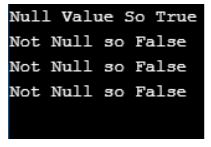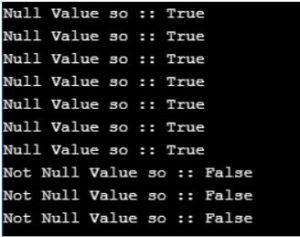Updated April 3, 2023
Introduction to PHP is_null()
The PHP is_null() function is actually an in-built function of the PHP Programming Language which help us to find whether the variable is a NULL value or not. The PHP is_null() function works for PHP 4 and the above PHP versions which are introduced later after PHP 4 version. The type of the $variable_name parameter of the is_null() function is Boolean type value. Is_null() function of PHP accepts only one parameter and that too it is fully mandatory parameter. There are no optional parameters available inside of the is_null() PHP function.
Syntax:
is_null( $variable_name )Explanation of Parameter:
The is_null() function of PHP Programming Language usually accepts only one single parameter as mentioned in the above syntax.
$variable_name:The $variable name helps us to check whether the variable’s value is NULL or not. It is a mandatory parameter. There are no more optional parameters available inside of the is_null() function to mention.
Return value:
The is_null() function will return a Boolean value and the function is going to return TRUE only when the $variable_name is the NULL value, if the variable’s value is not NULL then it will return FALSE statement.
Working of is_null() Function in PHP
- PHP is_null() function woks based on the NULL values present inside of the function’s parenthesis.
- If the variable value inside of the is_null() function then the result will be TRUE and promotes the further conditions statement or any other.
- If the variable’s value inside of the is_null() function is FALSE then statements which are inside of the those conditions will not be executed.
- The value type of the PHP is_null() function is Boolean.
- The only parameter of the is_null() function is a mixed type (mixed type means that it is going to indicate that the parameter has the capability of accepting the multiple types but not necessarily all types).
Examples of PHP is_null()
Given below are the examples mentioned:
Example #1
In the below example, four variables is created with different variables and checked whether they are NULL values or not with the help of is_null() function of the PHP programming language. At first, $var11, $var12, $var13 and $var14 variables are created with different values for them. $var11 and $var13 variables are stored with “NULL” values. $var12 and $var14 values are stored with “\0” and 0 values. \0 is considered as NULL but here it is assigned as a string value. Then “is_null() ? TRUE : FALSE” structured syntax is used to print the TRUE statements/others only if the is_null($variable_name) is TRUE. If not FALSE statement will be printed. Likewise the code implements the results below. Checking the $var11 and $var13 variable’s values using the is_null() function will print the TRUE value whereas for other variables ($var12 and $var14) the result will be FALSE value.
Code:
<?php
$var11 = NULL;
$var12 = "\0";
$var13 = "NULL";
$var14 = 0;
is_null($var11) ?print_r("Null Value So True\n") : print_r("False\n");
is_null($var12) ?print_r("Null Value So True\n") : print_r("Not Null so False\n");
is_null($var13) ?print_r("Null Value So True\n") : print_r("Not Null so False\n");
is_null($var14) ?print_r("Null Value So True\n") : print_r("Not Null so False\n");
?>Output:
Example #2
This is the example of demonstrating the working of the is_null() function of the PHP Programming Language. At first, a function “check_null1()” is created with only one parameter “$var11” in it. Inside of the function is_null() function is created to check whether the variable parameter of the function is TRUE or NOT. But here variable value of $var11 is not mentioned. Function is closed and called many times with different inputs. “NULL” is mentioned/passed to the $var11 by changing the capitalization of the NULL words as values. But for the last 3 echo statements, different values passed to the variable parameter of the function. So for the last echo statements the result will be FALSE.
Code:
<?php
function check_null1($var11)
{
return (is_null($var11) ? "Null Value so :: True" : "Not Null Value so :: False");
}
echo check_null1(NULL) . "\n";
echo check_null1(null) . "\n";
echo check_null1(Null) . "\n";
echo check_null1(NUll) . "\n";
echo check_null1(NULl) . "\n";
echo check_null1(nulL) . "\n";
echo check_null1(nuLL) . "\n";
echo check_null1(nULL) . "\n";
echo check_null1('Nul') . "\n";
echo check_null1(false) . "\n";
echo check_null1(2). "\n";
?>Output:
Example #3
In the below example, $a1, $b1, $c1 and $d1 variables are created. NULL values are passed to $b1 and $d1 variables. Although “null” value is passed to the $c1 variable, but the NULL is passed as a string value. So the result of the $b1 and $d1 variable’s after checking with the is_null() function will be printed as empty value. For $a1 and $c1 variables, result will not all be print.
Code:
<?php
echo "For Non-NULL values the value will not be printed . Check Below :: \n";
$a1 = 0;
echo "a1 is :: " . is_null($a1) . "\n";
$b1 = null;
echo "b1 is :: " . is_null($b1) . "\n";
$c1 = "null";
echo "c1 is :: " . is_null($c1) . "\n";
$d1 = NULL;
echo "d1 is :: " . is_null($d1) . "\n";
?>Output:
Example #4
This is the example of checking for different $var11 variable’s values whether they are NULL or not. This is done by using different IF and ELSE conditions. At first, $var11 is stored with “TRUE” value and checked with the is_null() function so the ELSE condition result will be printed because the is_null(TRUE) function condition result is FALSE. Likewise for the second IF and ELSE condition, same result is printed. Then for the $var11 variable, “NULL” value is passed and then after checking with the is_null() function the result will show that “Variable var11 is NULL” like that.
Code:
<?php
echo "Checking for TRUE value of the var11 variable for NULL :: \n";
$var11 = TRUE;
if (is_null($var11))
{
echo 'Variable var11 is NULL';
}
else
{
echo 'Variable var11 is not NULL';
}
echo "\n";
echo "Checking for FALSE value of the var11 variable for NULL :: \n";
$var11 = FALSE;
if (is_null($var11))
{
echo 'Variable var11 is NULL';
}
else
{
echo 'Variable var11 is not NULL';
}
echo "\n";
echo "Checking for NULL value of the var11 variable for NULL :: \n";
$var11 = NULL;
if (is_null($var11))
{
echo 'Variable var11 is NULL';
}
else
{
echo 'Variable var11 is not NULL';
}
echo "\n";
?>Output:
Conclusion
Here we saw introduction of PHP is_null() function with the syntax and it’s parameters explanation, working of PHP is_null() function along with various examples which involves is_null() function to understand the is_null() function well.
Recommended Articles
This is a guide to PHP is_null(). Here we discuss the introduction, syntax, and working of is_null() in PHP along with different examples and code implementation. You may also have a look at the following articles to learn more –






